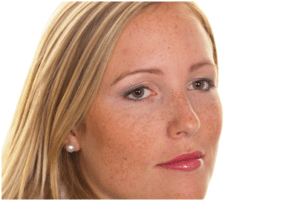All You Need To Know About Hyperpigmentation

Three Main Types of Hyperpigmentation
Sunspots
Sunspots are flat, dark spots caused by sun exposure and also referred to as lentigines, age spots or liver spots. They are commonly seen on the face, chest, and hands and associated with increasing age (increased sun exposure with time).
Treatment includes a combination of laser, chemical peels, and topical skincare products. The best treatment approach to this form of hyperpigmentation is prevention using a combination of sun avoidance and topical skin care products such as a sunscreen, antioxidant (C E Ferulic by SkinCeuticals), and retinoids (retinol, Retin-A). Once sundamage and sunspots have occurred, we may treat it using antioxidants and retinoids such as Retin-A which exfoliate skin, even skin tone, reduce fine lines and produce collagen. Finally, in patients with particularly bad photoaging and hyperpigmentation, we may elect to treat with a chemical peel, IPL (intense pulsed light) or fractionated lasers Clear + Brilliant.
Melasma
Melasma is a common skin condition seen more frequently in women then men and associated with sun exposure, oral contraceptive use, and pregnancy (mask of pregnancy). Melasma presents as irregular brown patches on the cheeks, forehead, bridge of nose, upper lip, and chin.
The gold standard treatment for melasma is hydroquinone. However, long-term hydroquinone use is not recommended. We usually “pulse” treat our patients with 4% hydroquinone for 2 months followed by a nonhydroquinone skin lightener for 6-8 months. Kojic acid, azelaic acid, and tretinoin (i.e. Retin-A) are great hydroquinone alternatives. Over the counter products such as those containing ascorbic acid (vitamin C) and retinols which are less irritating forms of tretinoin also help with melasma. Finally, chemical peels such as a glycolic acid peels and low energy, low density laser treatments like Clear + Brilliant Permea help treat melasma through exfoliation of the pigment containing skin cells.
Post inflammatory hyperpigmentation
Post inflammatory hyperpigmentation (PIH) is usually temporary pigmentation (most cases resolve within 2-6 months) and represents the skin’s response or reaction to some trauma whether that trauma be infection, acne, waxing, chemical peels or some energy based treatment such as a laser. While it will usually resolves on its own, we may choose to speed up resolution using various topical skin treatments such as hydroquinone, tretinoin, corticosteroid creams or a series of glycolic acid peels or light laser resurfacing. It is extremely important to avoid sun exposure when PIH does occur because sunlight can worsen the pigmentation.
While hyperpigmentation is common and a concern for many, we are happy to be able to write that there are many treatments and quality products now available to help brighten skin and even tone. However, at the end of the day, the most important thing to preventing pigmentation is strict sun avoidance. This can be accomplished using SPF 30+ sunscreen, wide-brimmed hats and sunglasses. This applies to patients with photoaging, melasma, and PIH.
If you are interested in meeting with our Harvard trained physician, Dr. Shaun Patel, to discuss solutions to hyperpigmentation, we invite you to schedule a consultation and evaluation at our beautiful Coral Gables clinic. Please call us at 786-618-5039 today.
